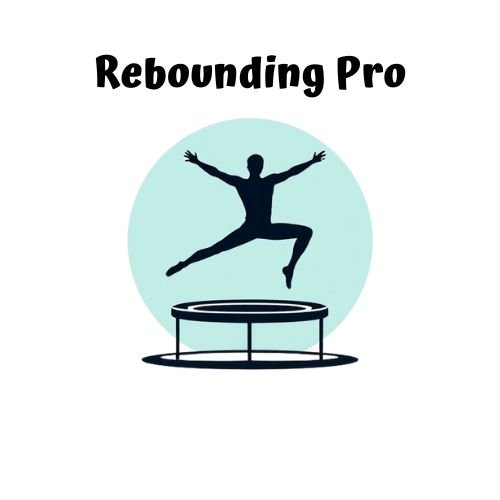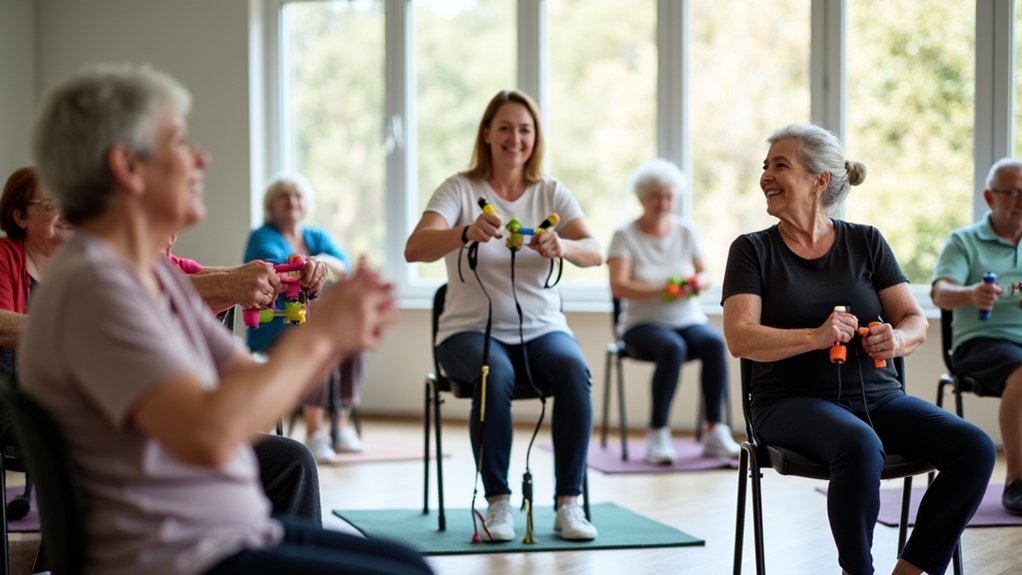Lymphatic exercise transforms your detox journey by enhancing your body’s natural waste removal system. When you bounce on a rebounder, you create pressure changes that propel lymph fluid through one-way valves, effectively flushing toxins from your system. This gentle movement can triple your white blood cell count, reduce inflammation, and improve skin clarity. Just 5-10 minutes daily delivers significant detoxification benefits, while proper technique matters more than duration. Discover how this simple activity can revolutionize your entire health picture.
The Hidden Detox System Within Your Body

While most people focus on their digestive system for detoxification, your lymphatic system works silently as your body’s primary waste removal network.
Unlike your circulatory system, which has a heart to pump blood, your lymphatic vessels rely on your movement to transport lymph fluid throughout your body.
This remarkable system extends almost everywhere in your body through a network of lymphatic capillaries, trunks, and ducts.
As lymph flows through lymph nodes, macrophages capture toxins, pathogens, and cellular waste before returning purified fluid to your bloodstream.
The spleen, thymus, and lymphatic tissues in your tonsils and gut further enhance this detoxification process.
When functioning at its best, your lymphatic system maintains fluid balance while simultaneously removing harmful substances from your tissues. It also plays a crucial role in the absorption and transport of dietary fats from the intestine to the bloodstream.
How Rebounding Activates Your Lymphatic Drainage
Jumping on a mini-trampoline—or rebounding—creates a powerful detoxification effect unlike any other exercise. Each bounce generates alternating G-forces that activate your lymphatic valves like one-way gates, propelling toxin-laden fluid through your system.
At the peak of your jump, you experience a zero-gravity moment that maximally stimulates lymphatic drainage. During landing, increased gravitational load forces fluid through vessels while muscle contractions compress lymph pathways. This full-body pump mechanism engages both superficial and deep lymph nodes with every movement.
Just two minutes of rebounding can triple your white blood cell count for up to an hour, accelerating cellular debris removal. The rhythmic pressure changes create a systemic cleansing effect that manual techniques can’t match, making rebounding particularly beneficial for lymphedema patients and anyone seeking enhanced detoxification. Establishing a daily routine leads to improved fitness outcomes and optimal detoxification benefits.
Getting Started: Essential Rebounding Equipment for Beginners

Before diving into lymphatic rebounding, you’ll need to select equipment that matches your specific needs and space constraints.
Consider your weight, available space, and potential joint sensitivities when choosing between bungee or spring rebounders.
For beginners focused on lymphatic detox, we recommend these essentials:
- Bungee rebounders – Ideal if you’re concerned about joint impact or noise, providing a gentler bounce that’s perfect for lymphatic stimulation without jarring movements.
- Folding models – Space-efficient options (half or quarter-fold) that store easily while maintaining the 39″-44″ diameter needed for effective lymphatic exercise.
- Balance aids – Handlebars or stabilizing rails that guarantee safety during your initial sessions, particularly important for seniors or those with balance concerns. Models with safety pads covering the springs offer additional protection against accidental foot slips during your lymphatic workouts.
Budget-friendly options start under $100, while mid-range models ($200-400) offer better durability and adjustable tension.
The Science Behind Bouncing and Toxin Removal
Rebounding creates a unique lymphatic pumping effect as you bounce, with rapid gravitational changes forcing your lymph valves to open and close more frequently.
Your body’s increased lymph flow during this exercise helps clear cellular waste that would otherwise accumulate in tissues.
Regular rebounding exercise complements other physical activities that stimulate lymphatic flow through muscle movement and contraction.
While your body naturally removes toxins, this enhanced lymphatic circulation may support more efficient waste clearance throughout your system.
Lymphatic Pumping Effect
While gentle bouncing exercises might seem simple, they activate a sophisticated biological mechanism known as the lymphatic pump.
When you bounce, you create oscillatory pressure changes that stimulate both intrinsic contractions from smooth muscle cells and extrinsic forces from your movement, dramatically improving lymph flow.
Your lymphatic vessels respond to this mechanical stimulation in three key ways:
- Pressure gradient enhancement – Bouncing creates fluid shifts that generate the pressure differences needed to propel lymph forward through one-way valves.
- Contractility boost – Wall stretching triggers calcium influx in lymphatic muscle cells, strengthening each contraction. The effectiveness of each contraction relies on proper valve functionality to prevent backflow.
- Flow synchronization – Rhythmic movement coordinates vessel contractions, optimizing the “squeeze and release” pattern that efficiently moves fluid through your system.
Cellular Waste Clearance
The scientific evidence behind lymphatic exercise reveals why bouncing effectively accelerates cellular waste clearance. When you bounce, you activate multiple systems that eliminate toxic buildup. Your muscle contractions function as natural pumps, stimulating lymph nodes to filter out harmful substances from your body fluids.
This movement creates a ripple effect throughout your detoxification pathways. Exercise enhances both lymphatic and blood circulation, facilitating the transport of waste products out of tissues. The lymphatic vessels contain one-way valves that ensure proper flow of lymph toward the collecting ducts during bouncing activities.
In your brain, physical activity stimulates the glymphatic system, improving cerebrospinal fluid flow and helping clear harmful proteins like amyloid beta.
Regular bouncing reduces inflammation while increasing your metabolic rate, which further supports toxin breakdown.
These mechanisms work together, creating a thorough approach to cellular detoxification that’s considerably more effective than sedentary living.
5-Minute Daily Lymphatic Rebounding Routines

Even just a few minutes of daily rebounding can revolutionize your lymphatic health without disrupting your schedule. This gentle bouncing activates your body’s natural waste removal system, compensating for your lymphatic system’s lack of an internal pump.
Consistency trumps intensity—a 10-15 minute daily practice produces measurable improvements in vascular health and drainage efficiency.
Your ideal rebounding routine:
- Start small – Begin with 5-minute sessions and gradually increase to 10-30 minutes as your body adapts.
- Keep it gentle – Control your bounces without high jumps to maintain fluid movement without overtaxing joints.
- Prioritize posture – Maintain proper alignment during bouncing to maximize thoracic duct drainage and enhance detoxification.
The rebounding action creates twice the force of gravity with each landing, providing more effective stimulation than running for lymphatic circulation.
The 56.6% improvement in lymphedema symptoms seen in clinical trials confirms this approach works.
Common Rebounding Mistakes That Hinder Detoxification
When it comes to rebounding for lymphatic detox, you’re likely prioritizing frequency over proper technique, which can drastically reduce the effectiveness of your efforts.
You might also be using the wrong type of surface—soft, high-quality rebounders stimulate lymph flow better than rigid or cheap alternatives.
Starting with foundational workouts before attempting advanced rebounding routines is essential for maximizing lymphatic circulation and preventing common injuries that new rebounders experience.
Correcting these common mistakes will transform your rebounding sessions from merely bouncing to genuinely beneficial detoxification exercises.
Technique Over Frequency
Many rebounders mistakenly believe that frequency trumps technique when it comes to lymphatic detoxification, yet this approach often yields diminishing returns. Your body’s detoxification efficiency depends more on how you bounce than how often.
When rebounding for lymphatic health, focus on these critical elements:
- Consistent bouncing rhythm – Irregular bouncing patterns disrupt the ideal gravitational pull needed for effective lymph flow.
- Proper foot positioning – Balance on the trampoline ensures total body engagement and maximizes lymphatic valve stimulation.
- Gentle, low-impact movements – These activate lymphatic drainage more effectively than intense sessions that lead to overexertion.
The mini-trampoline’s low-impact nature makes it an excellent choice for those concerned about joint health while pursuing detoxification benefits.
Don’t sacrifice form for frequency. Short, technically sound sessions will serve your detoxification goals better than longer workouts with poor execution.
Wrong Surface Selection
Selecting the wrong surface for lymphatic rebounding can sabotage your detoxification efforts before you even begin. Hard surfaces like concrete lack shock absorption, increasing joint impact while diminishing the essential G-force benefits needed for lymphatic valve stimulation.
Your bounce quality matters immensely. Non-elastic materials limit rebound height, decreasing gravitational differentials critical for proper lymph flow. Unstable or uneven surfaces disrupt the rhythmic bouncing pattern, preventing consistent gravitational pull that activates your lymphatic system.
Pay attention to shock absorption levels—insufficient cushioning amplifies ground reaction forces while excessive padding dampens rebound efficiency. Both extremes compromise lymphatic drainage.
For ideal detoxification, choose rebounders with balanced elasticity that create the “weightless moment” necessary for opening lymphatic valves and promoting vertical fluid movement throughout your system. A proper rebounder workout provides significant advantages over traditional walking by enhancing lymphatic health through controlled vertical motion that effectively moves lymph fluid through the body.
Measuring Your Detox Progress Through Rebounding
Three key indicators reveal your body’s detoxification progress when following a consistent rebounding routine. Unlike traditional exercises, rebounding creates a unique gravitational flow that flushes your entire lymphatic system in just two minutes of continuous bouncing.
- Physical transformations – Notice reduced swelling in your extremities, improved skin clarity, and faster muscle recovery as lymphatic drainage improves.
- Energy and cognition – Experience increased energy levels and mental sharpness as your body efficiently removes metabolic waste and neurotoxins.
- Performance metrics – Track your advancement from short 5-minute sessions to 30+ minutes, along with improvements in bounce consistency and balance control.
Claims about rebounding’s ability to activate the lymphatic system lack scientific evidence supporting its effectiveness for detoxification.
As you maintain your rebounding practice, chronic inflammation diminishes and toxin-related fatigue patterns fade—typically within 6-8 weeks of consistent lymphatic stimulation.
Combining Rebounding With Other Lymphatic Stimulation Techniques
While rebounding serves as an exceptional foundation for lymphatic health, its benefits multiply greatly when combined with complementary techniques. By integrating diaphragmatic breathing during your bounce sessions, you’ll stimulate deeper lymphatic structures while reducing stress that can impede your body’s natural detox processes. Shoulder rolls can also be incorporated before rebounding to prepare the upper body lymphatic pathways for increased circulation.
| Technique | Benefits | Integration Method |
|---|---|---|
| Diaphragmatic Breathing | Deep lymphatic stimulation, stress reduction | Inhale for 4 counts while bouncing gently |
| Manual Lymphatic Drainage | Targeted node stimulation, reduced inflammation | Apply before rebounding sessions |
| Walking | Gradual lymphatic flow, cardiovascular support | 10-minute walk after rebounding |
| Soft Tissue Mobilization | Reduced muscle tension, increased mobility | Focus on chest and shoulders post-rebound |
You’ll experience more efficient toxin removal when you combine these approaches, creating a thorough detox strategy that addresses multiple pathways for lymphatic circulation.
Beyond Detox: Additional Health Benefits of Lymphatic Rebounding
Rebounding offers far more than just detoxification benefits for your lymphatic system. This low-impact exercise creates a cascade of positive effects throughout your body by improving circulation, strengthening cells, and enhancing your immune response.
Here’s how regular rebounding transforms your overall health:
- Immune System Boost – Your white blood cell count triples within minutes of bouncing, remaining elevated for up to an hour after exercising, greatly enhancing your body’s natural defense mechanisms.
- Metabolic Enhancement – You’ll burn 3-5+ calories per minute while improving mitochondrial efficiency and hormonal regulation, making weight management more effective.
- Cardiovascular Strengthening – The rhythmic bouncing improves heart health by increasing stroke volume, enhancing oxygen utilization, and promoting better blood pressure regulation. According to NASA research, this exercise is 68% more effective than jogging for cardiovascular conditioning.
Frequently Asked Questions
Can Lymphatic Exercises Help With Autoimmune Conditions?
Yes, lymphatic exercises can help with your autoimmune conditions by improving circulation, reducing inflammation, and enhancing immune cell regulation. They’re often effective for managing symptoms of rheumatoid arthritis, lupus, and other autoimmune diseases.
How Does Lymphatic Detox Affect Skin Conditions Like Eczema?
Lymphatic detox may help your eczema by reducing inflammation and clearing toxins that trigger flare-ups. You’ll potentially see less redness, swelling, and irritation as improved lymph flow removes inflammatory cytokines from affected skin areas.
Are Lymphatic Exercises Safe During Pregnancy?
Yes, you’re safe to perform gentle lymphatic exercises during pregnancy. They’ll help reduce swelling and boost circulation. Just avoid deep abdominal work, get professional guidance, and elevate your legs to maximize benefits safely.
Can Children Benefit From Lymphatic Stimulation Techniques?
Yes, children can benefit from lymphatic stimulation techniques. You’ll find techniques like cervical stimulation and parent-administered MLD show promising results for pediatric lymphedema, improving well-being and reducing symptoms, even with modest volume reduction.
How Do Medications Impact Lymphatic System Function During Exercise?
Medications can both hinder and help your lymphatic system during exercise. Calcium channel blockers impair lymph contractions, while diuretics may enhance fluid clearance. You’ll need properly timed workouts to offset potential medication-induced dysfunction.
In Summary
You’ve now discovered how lymphatic rebounding can transform your detox journey. By dedicating just minutes daily to this gentle bouncing exercise, you’re activating your body’s natural cleansing system. Don’t wait to experience clearer skin, improved energy, and reduced inflammation. Start your rebounding routine today and you’ll wonder why you didn’t incorporate this powerful, accessible practice into your wellness routine sooner.





Leave a Reply